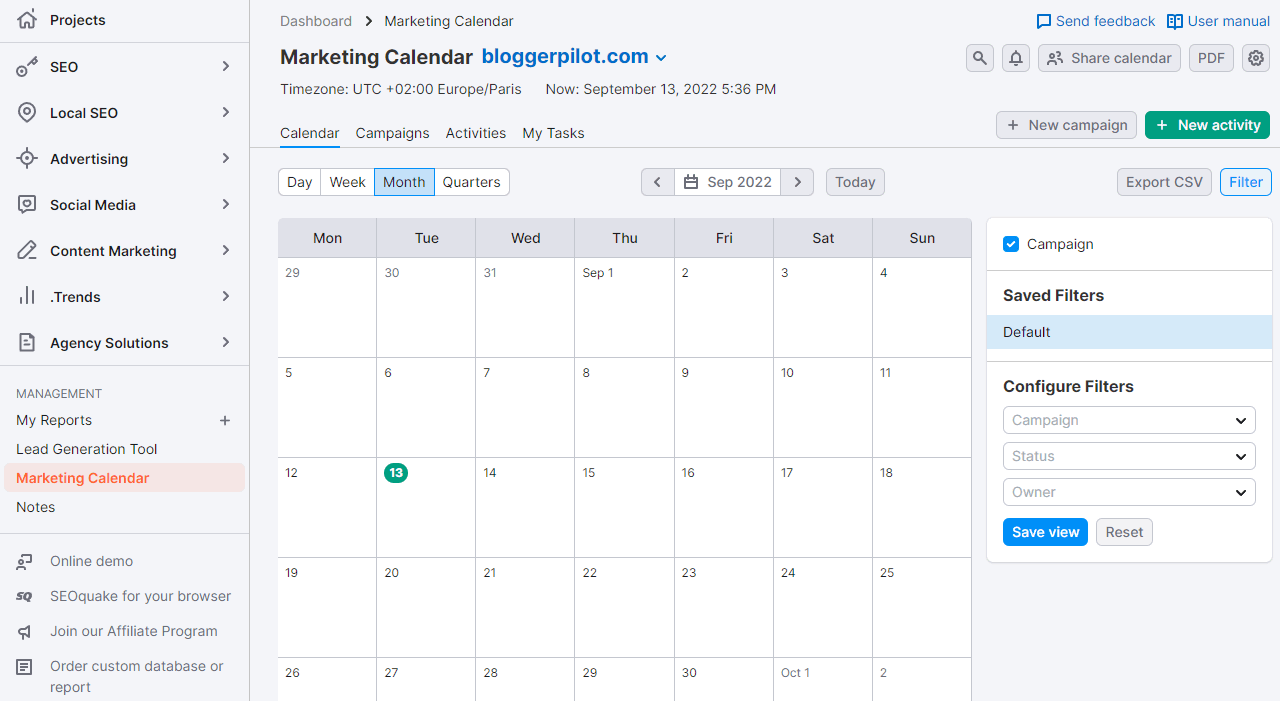Content Marketing Strategies: How to turn your blog into a customer magnet
Content marketing is now one of the most important tools in the digital marketing mix. Blogs in particular have established themselves as a valuable resource for companies of all sizes. But a blog can do much more than drive traffic to your website.
A strategically well-thought-out blog has the potential to be a real “customer magnet”. It can not only generate interest, but also build trust and ultimately convert readers into paying customers. In this article, you’ll learn how to make that happen.

☝️ Key points at a glance
- 🎯 Strategically thought-out blogs can attract not only traffic, but also paying customers.
- ✍️ Quality over quantity: Well-researched and carefully formulated posts improve SEO performance.
- 🔍 In-depth research and clear, understandable writing style are crucial for content quality.
- 🧠 The art of storytelling: Stories create emotional connections and increase the credibility of the blog.
Why content quality trumps quantity
In the world of content marketing, quality is definitely more important than quantity. While it may be tempting to fill your blog with numerous posts to increase visibility, it’s more effective to focus on well-researched and carefully worded content.
Quality posts not only attract an engaged readership, but also improve SEO performance. Google and other search engines evaluate the relevance and quality of content, and well-written articles with more in-depth information are ranked preferentially.
- In-depth research: In-depth research forms the basis for high-quality content. It makes it possible to offer unique insights and detailed information that goes beyond general expertise.
- Clarity and comprehensibility: A straightforward, easy-to-understand writing style promotes reading pleasure and facilitates information absorption.
- SEO performance: Google evaluates the relevance and quality of a post. Well-structured articles that convey profound knowledge therefore have a better chance of ranking highly.
For example, a detailed guide on a specific topic can not only serve as a useful resource, but also generate organic backlinks that benefit your SEO. Moreover, well content promotes customer loyalty and creates an authority in your industry.
To improve the quality of your content, it is recommended to conduct extensive research and present the information in a clear, understandable style. Using relevant keywords, meta descriptions, and high-quality images or graphics are also important factors. Focus on creating value for your readers, and success won’t be long in coming.
The art of storytelling in blog posts

Storytelling is one of the most effective ways to capture readers’ attention and create an emotional connection. Studies show that our brains process stories differently than mere information. Reading or listening to a story activates areas of the brain that evoke emotions, images and memories. This makes stories a powerful tool that goes far beyond simply conveying information.
- Contextual integration: a good story should not stand in isolation, but fit seamlessly into the overarching context of the article.
- Authenticity: real, authentic stories have a much higher emotional impact than made-up or generic narratives.
- Factual support: the emotional story can be supplemented with factual data and facts to strengthen the argument.
Effective use of storytelling in blog posts requires more than just telling an interesting story. The narrative should be seamlessly embedded in the context of the article and provide clear value to the reader. For example, a blog post about sustainable fashion might begin with a personal story about how the author came to realize that sustainable consumption is important. This narrative can then be linked to factual information and data to strengthen the argument.
A practical example of successful storytelling is the blog of “Charity: water,” a nonprofit organization that tells stories of people who have benefited from its projects. Such real-life stories provide emotionality, make complex topics tangible, and increase the credibility of the blog.
So by using storytelling skillfully, you can not only inform, but also inspire and move.
Content planning and editorial calendar

An effective editorial calendar is critical to content marketing success. It helps you plan content in a timely manner, make the best use of resources, and maintain a cohesive marketing strategy.
Advantages of an editorial calendar
- Structure: a calendar keeps things organized and provides an overview of upcoming publications.
- Consistency: Regular publications increase reader engagement and improve SEO rankings.
- Team coordination: a centralized schedule facilitates collaboration between editors, designers, and marketing teams.
Key components
- Content type: article, listicle, tutorial, etc.
- Publication date: Set date and time.
- Responsible party: Person or team responsible for creation and review.
- Status: In progress, Review, Published.
Your editorial plan could look as simple as this:
| Content Type | Publication date | Responsible | Status |
|---|---|---|---|
| Article | 01.11.2023 | Jochen | Draft |
| Listicle | 05.11.2023 | Sarah | Planned |
| Instruction | 12.11.2023 | Jochen | In progress |
Tools for content planning
- Google Docs: simple and free. Good for small teams.
- Trello: Visual representation of the editorial process.
- WordPress Plugin: Specialized plugins for editorial work directly in the CMS.
- Semrush: Use Semrush’s marketing calendar to plan directly in your SEO toolbox.
Strategic considerations
- Target audience analysis: Knowing your target group helps to select relevant topics.
- Keyword research: For better visibility in search engines.
- Performance analysis: Review KPIs to measure the success of your content.
A well-designed editorial calendar is more than a to-do list. It’s a strategic tool that helps you efficiently plan and manage high-quality content.
Measurable goals in content marketing: the role of KPIs

Measurable goals are essential in content marketing. Not only do they provide guidance, but they also allow you to evaluate ROI (return on investment).
Why are KPIs important?
- Goal focus: KPIs provide clear objectives that can focus the entire team.
- Performance measurement: KPIs show which strategies and tactics are successful and which need to be adjusted.
- Resource management: analyzing KPIs allows you to allocate resources more effectively.
Setting KPIs: What to consider
- Relevance: The KPI should be relevant to the overall business objective.
- Measurability: Goals must be quantifiable.
- Achievability: Unrealistic KPIs tend to demotivate rather than encourage.
Frequently used KPIs in content marketing
| KPI | Description | Measurement tool |
|---|---|---|
| Page views | Number of visits to a web page | Google Analytics |
| Dwell time | Time a user spends on the page | Google Analytics |
| Conversion rate | Percentage of users who take an action | Conversion Tool |
| Social Shares | Number of social media shares | Social media tools |
Strategic implications
- Trend analysis: long-term monitoring of KPIs can reveal trends that are useful for future strategies.
- ROI calculation: KPIs are essential for calculating ROI to verify the profitability of marketing efforts.
Establishing and measuring KPIs are critical elements for content marketing success. They allow an objective assessment of performance and provide starting points for optimization.
Comprehensive SEO strategies: Seeing the big picture
SEO (Search Engine Optimization) is an indispensable part of any successful content marketing strategy. While most people immediately think of keywords when they think of SEO, it’s actually about much more. Keywords are important, but modern SEO strategies consider a variety of factors to improve a blog’s visibility in search engines.
- Meta descriptions: They provide a quick overview of the content and can influence click-through rates.
- Internal Linking: Smart linking of one’s content can improve both the user experience and search engines’ understanding of the website structure.
- Mobile-First: In an era where a large percentage of traffic comes from mobile devices, mobile optimization is essential.
In addition to keyword optimization, meta descriptions also play an significant role. They provide users with a brief overview of the content of a page and can significantly influence the click-through rate (CTR). Internal linking is another often overlooked aspect of SEO. By intelligently linking your content, you can improve the user experience and give search engines a better overview of your website’s structure. Furthermore, mobile optimization is essential in an era where more and more search queries are coming from mobile devices.
- Depth of content: deep and varied content that solves specific problems of the target audience creates real added value.
- Interactive elements: Incorporating interactive elements such as quizzes or surveys boosts user engagement rates and can contribute to community building.
Tools like Google Analytics provide valuable insights into user behavior and can help you adjust your SEO strategy. You can get information about traffic origin, time spent on page, and bounce rate, which can give you clues about potential areas of improvement.
In today’s complex SEO landscape, it’s important to think beyond just keyword optimization and adopt a comprehensive strategy.
Customer loyalty through added value and community building

Customer retention is central to modern content marketing and goes far beyond simply selling products or services. The key is to add value through useful and informative content. Whether it’s guides, webinars or expert interviews – when you offer your customers concrete solutions and helpful information, you create a basis for a long-term relationship.
Social media and email marketing play a crucial role in community building. Through targeted social media campaigns and well-designed email newsletters, you can build a community of loyal customers and prospects who interact with your content regularly. This not only creates a platform for sharing information, but also for adding emotional value, for example through exclusive offers or insider news.
Interactive elements such as polls, quizzes, or live webinars can further boost the engagement of your readers. These allow users to actively participate and share their opinions and needs. As a result, readers feel more connected to your brand and are more likely to get returning customers.
A blog as a customer magnet – Here’s how to make it work!
A well-designed blog is more than just an information platform; it can be a real customer magnet. The key elements for this are high-quality content that creates added value, as well as advanced SEO strategies that go beyond mere keyword optimization. The art of storytelling and incorporating interactive elements can increase reader engagement, while social media and email marketing are critical to building a loyal community.
As you continue to develop your content strategy, it’s important to combine these different aspects and regularly review what’s working and what can be improved. Tools like Google Analytics can provide valuable insights. Invest in the quality and relevance of your content and focus on the added value for the reader to gain not only traffic but also loyal customers.
👉 Here’s how to proceed
- Content analysis: Review existing content on the blogs or websites you write for. Identify which posts have the highest engagement rate and consider how you can expand on those topics in future articles.
- Strategize: Set clearly defined goals for your future posts. Consider both short-term and long-term implications. An editorial calendar can be a valuable aid here.
- Technical optimization: Consider whether your blogs are optimized for search engines. If not, it might be wise to invest in SEO tools or bring in experts for a consultation. Also pay attention to the usability of your website because it can significantly influence readership.
